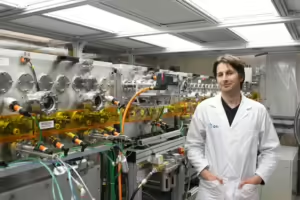OTI Lumionics has developed a sophisticated platform that combines simulations, machine learning, and experimental design to accelerate the pace of inventing new materials. The company is backed by LG Technology Ventures, Samsung Ventures, and UDC Ventures. Its approach integrates state-of-the-art quantum chemistry simulations on high-performance computers and GPUs with advanced machine learning algorithms. By leveraging data collected in laboratory and production settings, OTI helps design materials capable of meeting rigorous standards for mass production.

At the core of OTI Lumionics’ platform are quantum chemistry simulations used to estimate optoelectronic properties of OLED materials, such as optical gaps and emission spectra. These simulations involve solving the Schrodinger equation for molecular electrons, requiring extensive computational resources to calculate electron integrals, invert matrices, and optimize coefficients. The results from these simulations help estimate material properties before synthesis, significantly reducing costs.
The platform employs advanced machine learning techniques, such as deep neural networks, to map molecular information into an abstract vector space. This approach allows OTI Lumionics to identify the best candidates for materials, optimizing experiments to maximize the success of discovering viable materials.
Unlike traditional material discovery operations that often overlook scale-up and device performance, OTI Lumionics’ platform starts by simulating candidate materials for ease of synthesis and scalability. Thermal property and chemical engineering calculations are prioritized, ensuring that materials not only perform well in the lab but also succeed in manufacturing and are cost-effective to scale.
Recently, OTI Lumionics announced a new project in partnership with Nord Quantique. This collaboration aims to explore novel quantum theories to discover new materials for OLED displays, with the potential to shorten development times and reduce overall costs. The partnership will focus on electronic structure calculations, vibronic spectra, and ab initio molecular dynamics (AIMD) using quantum simulations.
Scott Genin, Vice President of Materials Discovery at OTI Lumionics, highlighted the limitations of existing quantum computing architectures, such as photonic, ion-trap, and neutral atom quantum computers, for running electronic structure or vibronic spectra calculations. Nord Quantique’s unique architecture and approach to quantum error correction are considered suitable for these applications, offering fast computational speeds and low energy consumption. This collaboration aims to identify improved efficiencies for developing advanced materials applicable in multiple industries, including semiconductors, pharmaceuticals, and specialty chemicals.
NGen, an innovation cluster supporting quantum technologies commercialization, has awarded the partnership $1.5 million. The funding will be utilized to expand teams, acquire equipment, and conduct necessary testing.

